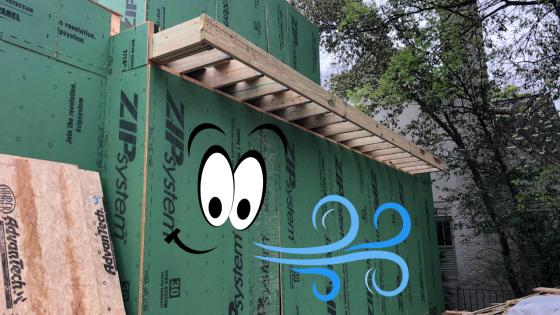Green Building Community
Pros and Cons of an airtight house
Posted by: Matt Hoots // Rate It Green Admin

A house needs to breathe, right?
Yes, they do, but not the way most builders or homeowners think they do. Many argue for a leaky house to allow the house to breathe. That is one method to get fresh air. However, it is not the most cost-effective or healthiest method.
The phrase “build tight and ventilate right” summarizes how to create an efficient and healthy home. If you do one without the other, there are serious consequences hence the misperception that the “house needs to breathe.” Let’s explore both sides of this equation, the benefits of proper design, and potential issues if done incorrectly.
Building an airtight house can have several benefits, including:
-
Energy efficiency: An airtight house can significantly reduce energy consumption by minimizing air leakage and heat loss. This means that the heating and cooling systems in the house will operate more efficiently, leading to lower energy bills and reduced greenhouse gas emissions. As the house loses less energy through the walls, the HVAC system will also be smaller, so installing costs less.
-
Improved indoor air quality: An airtight house allows better control over the ventilation system, ensuring fresh air enters the house through controlled ventilation rather than cracks or gaps in the building envelope. This helps to keep out pollutants and allergens, leading to improved indoor air quality and better health for the occupants. One of the main issues with “a house needs to breathe” is that you could be bringing in toxic air instead of fresh air.
-
Comfort: Airtight homes tend to have more consistent indoor temperatures and fewer drafts, leading to greater comfort for occupants. This is especially noticed in the winter when cold drafts come through the house on a windy day.
-
Noise reduction: An airtight home can also reduce noise levels from outside, providing a quieter and more peaceful living environment. Tight, energy houses are quieter because the sound does not travel through the open gaps, and the extra insulation also reduces sound.
-
Increased durability: An airtight house can be built to be more durable as it is less prone to moisture and air infiltration, which can cause damage over time. This can result in lower maintenance costs and a longer lifespan for the building. Some claim better building methods can increase the lifespan to 500 years from the code-built 30-year house.
Overall, an airtight house can provide a comfortable, healthy, and energy-efficient living environment while also reducing the impact on the environment. While an airtight house can offer several benefits, it can also experience some issues.
Issues may occur in an airtight house if ventilation is ignored.
-
Poor indoor air quality: If the house is not properly ventilated, there may be a buildup of pollutants, allergens, and other harmful substances inside the house, which can affect the health of the occupants. Ventilation with mechanical air filtration can help reduce the pollutants in the air.
-
Moisture buildup: An airtight house may experience moisture buildup, especially in bathrooms and kitchens, which can lead to mold and mildew growth. This can cause structural and surface damage and health problems for the occupants. Sensors that detect bad indoor air quality in these areas can inform the ventilation fans to turn on to remove these pollutants.
-
Overheating: An airtight house may trap heat inside the building during the summer, making the interior uncomfortably warm. This can result in increased energy consumption for cooling systems and reduced comfort for occupants. Windows designed for the climate zone and installing enough insulation will help reduce solar heat gain in warmer climates, so this can be avoided.
-
Lack of fresh air: If the ventilation system is not designed properly, the occupants may not receive enough fresh air, leading to a stale and stuffy indoor environment. We recommend an Energy Recovery Ventilator (ERV) or Heat Recovery Ventilator, depending on where you live.
To avoid these issues, designing and building an airtight house properly is essential, including a well-designed ventilation system and proper moisture control measures. Regular maintenance and monitoring of indoor air quality can also prevent these problems from occurring.
An example of a tight house with good ventilation
Check out the #1920sMakeoverATL Deep Energy Retrofit project. It is the first Passive House in Georgia, designed for maximin comfort, occupant health, and energy efficiency.
We are “building tight” by using the Huber Zip System, getting the overall leakage down to .3 ACH50, which is pretty tight since the requirement for Passive House was .6 ACH50. For ventilation, we are using Panasonic ERVs controlled by Swidget sensors to maximize fresh air for the future occupants of the house.
If you'd like to learn more about proper air sealing and insulation, check out these related topics:
- Why Air Sealing and Insulation are Both Essential
- What is ACH50, and Why does it Matter?
- What is a "Water Resistant Barrier" (WRB), Examples and Misconceptions
- The “Perfect Wall” Defined and Demonstrated
- 50% of the "Perfect Wall" Control Layers with One Product
And stay tuned for more information about proper ventilation and optimizing airtight homes. You can also always visit the #1920sMakeoverATL page for information related to this exciting project.
Please be kind and respectful!
Please make sure to be respectful of the organizations and companies, and other Rate It Green members that make up our community. We welcome praise and advice and even criticism but all posted content and ratings should be constructive in nature. For guidance on what constitutes suitable content on the Rate It Green site, please refer to the User Agreement and Site Rules.
The opinions, comments, ratings and all content posted by member on the Rate It Green website are the comments and opinions of the individual members who posts them only and do not necessarily reflect the views or policies or policies of Rate It Green. Rate It Green Team Members will monitor posted content for unsuitable content, but we also ask for the participation of community members in helping to keep the site a comfortable and open public forum of ideas. Please email all questions and concerns to admin@rateitgreen.com

